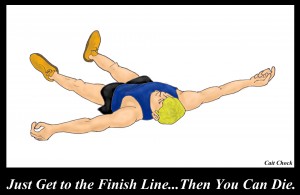Long runs and long workouts tend to scare people. It can feel intimidating looking down the barrel of a double digit run or mulit-mile repeats. We’re distance runners, we love this stuff, but large quantities of miles (especially faster miles) still intimidate us.
Running and that mental component, can’t escape the mind games. Our bodies are apt to surprise us and prove our limit-setting minds wrong…BUT it’s a matter of pushing past the mind crap (doubts/fears/discomfort) before we can be ‘pleasantly’ surprised.

The best thing about running into new territory, be it your longest run, the most number of long intervals, or the most volume of hard running, they’re all scariest before you do them. Once you’ve conquered the best you’ve proven you’re capable of it and you get a new frame of reference.
Example: You’re afraid of running 10 miles because you’ve never run that far. You then run 10 miles and flash forward a few weeks and 10 miles doesn’t scare you at all. But 14 miles does…sooo, you run 14 miles and the cycle continues.
See how DOING something takes the fear out of it. Let’s up the ante.
You can run 10 miles but now you’re supposed to run them hard. EEK!!! New challenge. Time to fight through it:
4 Steps to Get Through the Grind
1) Relax: the first part is you gotta stop building the run or workout up into epic proportions. Say with me, “it’s just a workout (or race), all I can is my best, so that’s the goal.” Deflate some of that pressure and take the power away from the workout…give yourself the power by realizing that you’re going to give it your all and THAT is all that can be expected. Times are there for guidance and motivation to push…but you can’t let them put so much pressure on you that you implode.

2) Start: easy peasy, right? Funny how fear sort of get muted the second the gun sounds and you just START freaking running. It has a way of shutting your brain down for a bit or at least taking it down a few notches.
3) Segments: your runner-brain gets overloaded thinking about the WHOLE run (26.2 miles…holy crap!!!) so you break everything down into smaller segments. Think of it like a meal with a zillion courses if you have to. Get through the plate, the miles, the quarter mile, the repeat.
4) Fight and Lie: running isn’t easy and training is painful. You break it down into itty bitty ‘plates’ but even each bite is still hard. (can I push this metaphor any further?) You need to just cycle through the above three steps on repeat…relax, roll, be confident, be smooth…start, click the watch on that next interval and go, make it until you hear the magic Garmin beep of another mile and keep going…segment, make it 100 meters more, run until you pass that guy, stick like GLUE behind the person in front of you and don’t think how far the finish line is in front of you.
Doing all of the above is really a series of lies. The good lies that you use to ‘trick’ your limit-setting brain into proving itself wrong. Your body CAN keep going, you just have to fight like h*ll long enough to show yourself you can do it.
The cool thing is once you get through the grind you’ve just re-calibrated what’s ‘suuuper scary’. Whatever you just did won’t scare you so much next time…
…but don’t rest too easily, Runners, because that just means later the ante will be upped. That’s okay, because you know the drill. 😉
——
“The Big Three: Talent vs. Work Ethic vs. Mental Toughness- Which matters the most?”
“Effective Mental Strategy: Race better by out-thinking your brain”
——
1) What’s the longest you’ve run?
2) What’s your favorite long repeats workout?
3) How do you get through the grind?



















